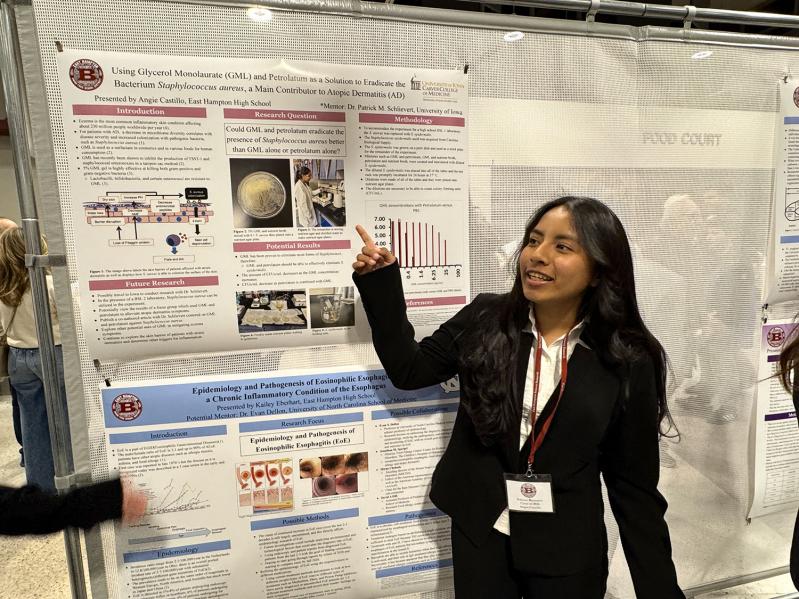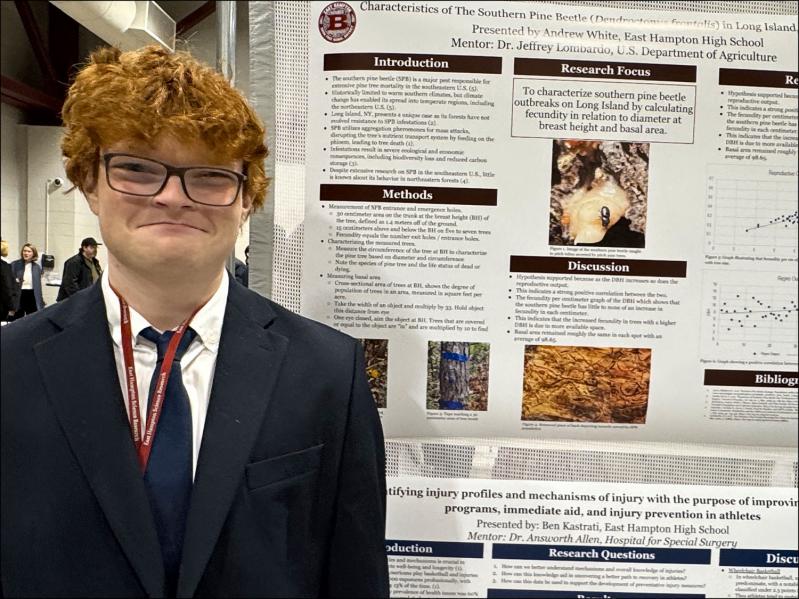Parents, government officials,and teachers, gathered at East Hampton High School last Thursday evening for the annual Science Research Symposium to see the work of more than 70 East Hampton students taking part in a three-year program that allows them to perform and investigate their own research topics, working with professional mentors in their field of study.
The program is run by Stephanie Forsberg, alongside Renee McGuire and Paul Rabito, all science teachers in the high school. According to Dr. Rabito the program has a “tremendous effect on the students themselves.”

“You see the trajectory that some of these kids have taken,” Dr. Rabito said at the event last Thursday night. “A lot of them end up in pre-med because of what they’re doing, a lot of them end up in research.”
“It’s actually changed a lot of what they thought they were going to do,” he continued, citing a student who graduated last year who first planned to be a theater major but is now studying botany at Cornell University.
Students have to be in their sophomore year to enter the three-year program, and they can earn college credits through the State University at Albany: four credits each for junior and senior years, and two credits for each of the two summers they study with the program.
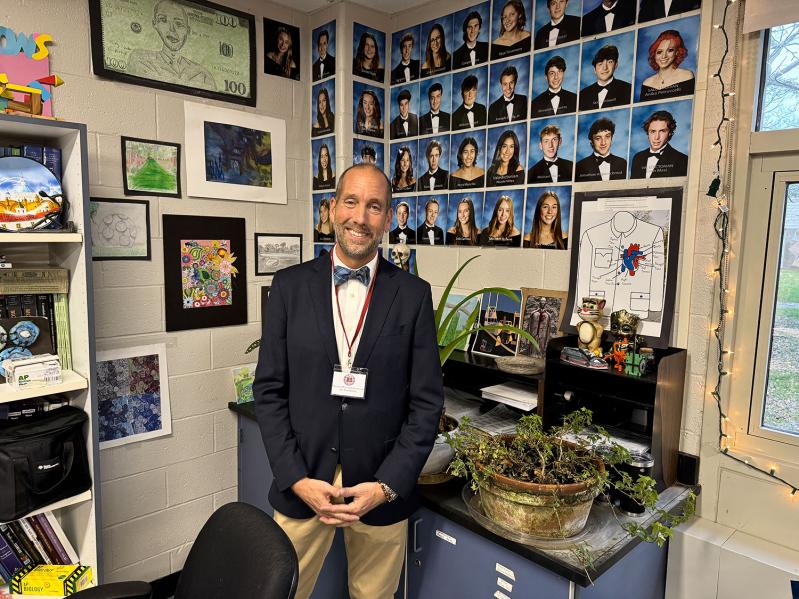
“They basically do paper research for the first half of their sophomore year, finding topics, finding what they want to do within that topic,” Dr. Rabito explained. A large audience saw the end result of their hard work live last Thursday night, as 19 seniors kicked off the symposium by presenting their projects in the auditorium.
Jocelyn Garcia spoke about her work researching the efficiency of a constructed square oyster reef. Stella Peterson presented her feasibility study on the application of geothermal energy at the high school, and Andrew White spoke about his studies of the southern pine beetle, which has devastated pitch pines on Long Island, their reach extending because of warming temperatures.
“Traveling northward is dangerous,” Andrew said, “as our local ecosystems are not prepared to deal with the cyclical nature of the species.”
For his research, Andrew focused on the reproductive success of the beetle in northeastern counties and on Long Island, mostly in the pitch pine tree. Their success was calculated by comparing entrance and exit holes in the trees. The reproduction counts rose in larger trees, but he noted that they did not increase “per centimeter.” The population is based on tree size rather than a difference between each individual tree, and it is not the only reason for their survival. “That means that there is an adaptation development happening,” he said.
As of last week, Andrew was still undecided on where he will go to college, but he plans to study English. His mentors on this study were Jeffrey Lombardo, a field researcher with the United States Department of Agriculture, and Matthew Ayres, a professor at Dartmouth College.
The class valedictorian, Abraham Stillman, and salutatorian, Ava Tintle, were also among the presenters. Abe discussed two projects he worked on. For the first two years he studied the relationship between alpha-gal syndrome, which causes an allergic reaction to pork and beef as a result of a tick bite, and blood type.
Through a blood-typing test of 825 participants he found that only 20 had detectable levels of alpha-gal, and of the 20 only one was blood type B or AB. “The prevailing theory that explains this is that blood type B has a protective factor,” Abe said.
He shifted topics in his third year to whether social vulnerability is a risk factor for strokes. “The social vulnerability index was created to assess community vulnerability for active disasters,” Abe said, “but we are assessing them as a public health risk assessment.” Through this research he found that increased social vulnerability does appear to raise stroke prevalence.
Abe presented this research to the Canadian Stroke Conference in November, and earned third place in the poster competition there. He also had his research published in the International Journal of Stroke in December.
Abe will attend Columbia University in the fall, majoring in biology. He was mentored by Dale Nordenberg, C.E.O. of Thriive.Ai.
Ava Tintle, an East Hampton class salutatorian, was mentored by Maria Piñango and Samantha Prince — a former class valedictorian — the latter two of Yale University, and presented her study on determining the location of metaphoric and ironic expressions in the brain.
She did this by working with pre-existing studies “recording coordinates of brain activation as a result from figurative language.”
“They did this using fMRI technology,” Ava said, “and having participants either read or listen to expressions with figurative language.”
Ava’s findings were consistent with her hypothesis; she saw brain activation in the areas of the right hemisphere that she suspected. She will attend Washington and Lee University in the fall, but is currently undecided on a major: She is considering mathematics, biology, or business. “Regardless of what major I choose, I know I will be joining on campus research next fall,” Ava said, “and the skills I have learned through this program, including working with a Ph.D. mentor developing research questions, will help me be prepared for the next steps next year.”
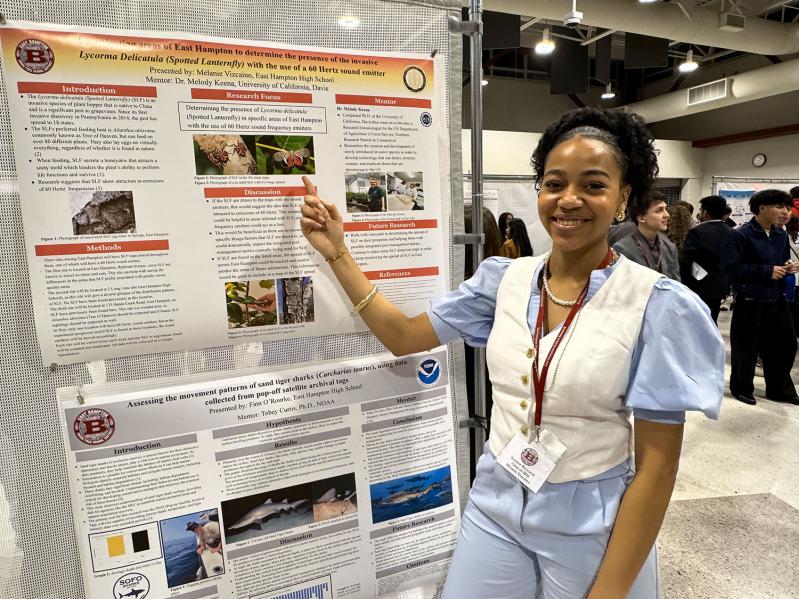
One of the most critical aspects of this program for the students is finding a mentor they want to work with, a process that Dr. Forsberg brought with her, according to Dr. Rabito.
“We had them give us a list of 10 or 12 colleges that they’re interested in,” he said, “and if they can find papers that are written by mentors that are at that college, it’s a foot in the door. So it works on so many different levels.”
The students sift through research papers from professors at these colleges and create the posters they presented last Thursday night. Then, when cold-calling potential mentors, “They use these posters as a calling card,” Dr. Rabito said, “when they send the cold-call email to them, and it works quite often.”
Ava Mintz, a sophomore, spoke about her ongoing search for a mentor. She wants to research how exercise can affect cognitive function, learning, and memory.
“I started off with Dr. Wendy Suzuki [of New York University], who I emailed first and she responded back and she didn’t have time,” she said. “She is a very busy and well-known doctor in this field.” She then reached out to Weiyun Chen at the University of Michigan, one of her top schools.
“She emailed me back saying she would love to work with me so I’m currently beginning my research with her and one of her master’s students,” Ava said. “They’re going to help me develop my research topic even more and explore the different parts of the brain and how exercise can improve it.”
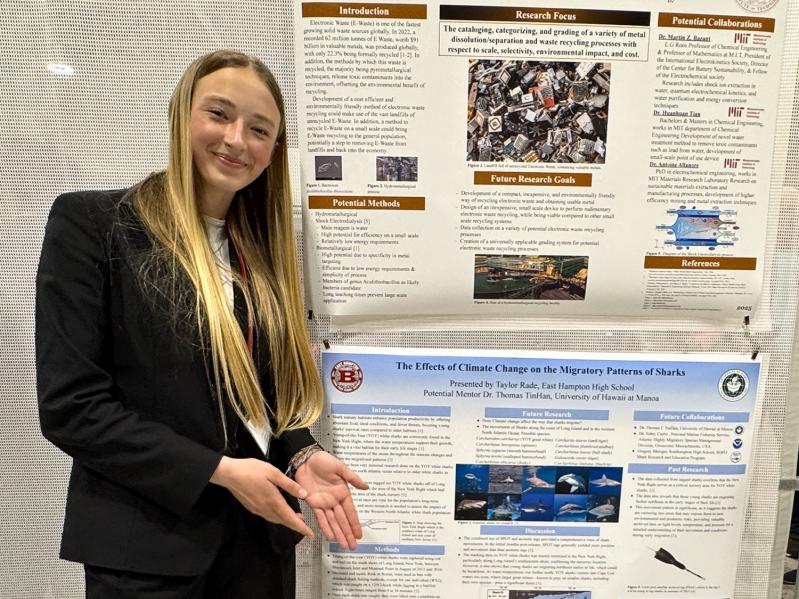
Throughout the presentations in the auditorium and a less formal presentation of their posters in the cafeteria later, it was clear that the students who participate in this program, even if they do not stay in the field of science, gain skills that will help them later both academically and in life.
“The science research program was a great opportunity for me to do long-term research,” Andrew White said during the senior presentations, “as there are not many other ways you can do this in high school. Additionally this helped me learn presentation and analytical skills.”
